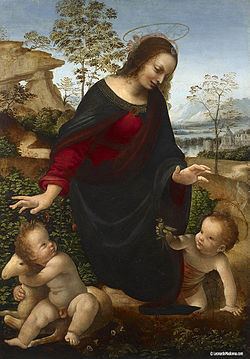Location Private collection | Artist Leonardo da Vinci | |
 | ||
Type Oil, tempera, gold on panel Dimensions 71.8 cm × 50.5 cm (28.25 in × 19.875 in) Year late 1470s - middle/late 1480s Similar Anatomical studies of the shoul, Studies of central plan build, Study of a woman's head, Head of a girl, Study sheet | ||
Virgin and Child with Infant St. John the Baptist is, from the technological and stylistic point of view, undoubtedly the work by Leonardo da Vinci and his workshop.
There is certain evidence proving that the work on this painting was implemented in several stages. At the first stage, the underdrawing was done and figures painted; at the second stage the landscape (or at least its major part) and the background were painted around the figures. The third stage involved possible changes to the representation of Infant St. John, the Lamb, and John's attributes, and in-painting the floral ornament to the figure of St. John and on the relatively small area to the left from the Child Jesus.
Among the known existing paintings on the same subject, the present painting seems to be most close to the works of Leonardo himself, which may be because here Leonardo did the underdrawing and painted at least the figures, and one of the artists of his circle completed the work.
The assumption that this is an unfinished work by Leonardo seems probable, due to the absence of the known existing original or at least full-scale cartoon while numerous copies dating from the late 15th and early 16th centuries are present. Indeed, it is hard to imagine that the composition has been developed and made into a painting by some other artist on the basis of known to us and mentioned above very small and schematic drawings by Leonardo, and that later this painting would be repeatedly copied by the artists of Leonardo's circle. The version of the unfinished painting by Leonardo is particularly viable in view of the master’s well-known habit of either leaving his works set aside for many years or completely unfinished.
The hypothesis claiming that the version from the Ashmolean Museum is the unfinished painting by Leonardo was expressed by T. Borenius back in 1930, and since then has not been disputed by anyone (although in the Ashmolean the painting is labeled as Leonardo's workshop). While accepting Borenius's version of the existing unfinished painting, it seems appropriate to make two clarifications: - first, the Ashmolean painting is not unfinished. Numerous losses of paint layer are due solely to its very poor condition; - secondly, T. Borenius did not know about the present painting reviewed in this report. Its level of performance is higher than that of the Ashmolean version, and moreover, it demonstrates more masterly underdrawing and clearly identified stages of creation. The beginning of works on this painting could be dated approximately between the late 1470s – middle/late 1480s. Its completion apparently coincides with the drawings of the Child with the Lamb (dates vary between 1500 and 1506) and the completion of the Virgin of the Rocks from the National Gallery (1506–1508).
The similarity revealed by the X-rays in the manner of painting the figure of Infant St. John on the examined artwork and the earlier Madonna of the Carnation is an interesting point. The main composition of the examined work can be approximately dated by the time of Madonna of the Carnation's creation (late 1470s – early 1480s.) and corresponds with the date of Leonardo's main drawing.
At the same time, Leonardo’s drawings of the Child with the Lamb are dated fifteen to twenty years later. The already-mentioned pentimenti of the face (and possibly figure) of Infant St. John as well as the turn of the Lamb's head, attesting to the later changes introduced to the original composition, may provide the possible key to explaining the significant time difference between the introduction of the painting's constituent elements.
Rather poorly-done floral ornament, in-painted around the figures of John and Jesus, dates back to the same late time. As for St. John's staff-like cross and cartouche on the earth at the foreground (probably with the typical inscription Ecce Agnus Dei), those attributes have been closed. The artist considered them redundant in the presence of the Lamb.
Given the evident portrait similarity between the Infants Jesus and John, some obvious semantic parallels with Leonardo's uncanonical concept of the existence of not one but two Messiahs come to mind, the idea that has probably driven the commissioner (Brotherhood of the Immaculate Conception) to reject in 1483 Leonardo’s Virgin of the Rocks (the Louvre).
If we consider the analyzed painting to be the source for all other copies, we should believe that it must have remained for some time without any attributes of the Infants, followed by the period with all of St. John's attributes when the Pitti and Château de Flers copies were taken from it. As for the copy from the Ashmolean Museum, it could have been done after the staff-like cross and the cartouche disappeared from it.
Provenance
- According to some sources over several generations belong to an Italian aristocratic Collection;
- Anonymous sale as Leonardo’s work; Sotheby's, London, 23 July 1952, lot 127. Private collection, Europe;
- Sold as Circle of Leonardo da Vinci, Christie’s, New York, 29 January 2014, sale 2819, lot 141;
- Sold as Private Sell Christie's, London March, 2014.
The painting is listed in the catalogue of Fondazione Federico Zeri (Italy), entry number: 34220, as work of Leonardo da Vinci (circle). Its current location is indicated as unknown.
